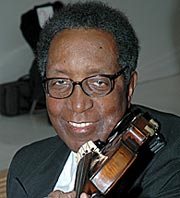Pioneer in field dedicated to minority heart care
Elijah Saunders, MD, the first black cardiologist in Maryland, tells Today in Cardiology about seeking changes in a segregated society.
Click Here to Manage Email Alerts
Elijah Saunders, MD, is more than just an active researcher, established author, lecturer, teacher, mentor and leader in the hypertension field; he was one of the first to break down racial barriers at the University of Maryland School of Medicine.
“I was the first black cardiologist in the state of Maryland, the first to be trained at the University of Maryland in their cardiology program, the first resident in internal medicine, and the class of 1960 – my class – was the first class to have more than two black students graduate,” said Saunders, a member of the Hypertension and Vascular Disease section of the Today in Cardiology editorial board. “We graduated four out of about 140 students. The experience alone was something.”
A move for integration
Saunders was influential in abolishing segregated hospital wards at the university. Although there was no compromise to his training, he said each day was a challenge seeing how patients treated black staff members differently. In 1963 when he was a cardiology fellow, Saunders and a few colleagues decided to make a move with total integration of the hospital wards.
“We admitted patients the way we thought they should be admitted; we put black patients in the rooms with white patients. No one told us to do it or not to do it; we just did it and thought we were going to get thrown out the next day,” he said.
That never happened. There was no backlash, just colleagues questioning their stance and urging them to reconsider what they were doing.
“The chief resident, who was Jewish, and I stuck our necks out to make a change and the other students and most staff immediately supported us,” he said. “From there on things began to change.”
Continuing issues
|
Chief of the Section of Hypertension, University of Maryland Medical Center Founder of the Association of Black Cardiologists Co-founder of the International Society on Hypertension in Blacks |
Saunders contends that racial disparities still persist, as well as other challenges for minority patients. Even from the beginning of his career, it was clear to Saunders that hypertension was either a cause of heart disease in blacks or it was a concomitant problem among this subgroup.
“CVD of all kinds and coronary disease, the number one heart problem, is common in blacks. The mortality and death rate from CVD is higher in blacks than whites,” he said. “This may be a part of the differences in quality of care. The black community is not benefiting from advancements as much as the white community.”
Other problems among minorities that continue are the disproportionate effects of diabetes, obesity, metabolic syndrome and social issues such as economic disparities, social stress and experiences with racism in all health arenas.
The significant shortage of minority providers in the cardiovascular field is also an issue, according to Saunders. Various studies have found that most minority patients and non-minority patients prefer providers of similar race, because they feel they are more sensitive and can relate to a patient’s culture and ethnicity.
“We are not recruiting black and minority cardiologists properly and this is a challenge, one that we are concerned about,” he said. “It is a big issue around the country. But if the provider is culturally sensitive and competent, then it doesn’t matter what ethnicity the provider is because he or she can serve the community quite well.”
Paving the way
A graduate of the University of Maryland School of Medicine, Saunders completed his postgraduate training at the same institution and is now professor of medicine (cardiology) and head of the section of hypertension at the university. Saunders was also born at the university.
“As my wife likes to say, I never left the crib,” Saunders told Today in Cardiology.
Saunders’ passion in the field is minority health issues, specifically among blacks. He specializes in research of pharmacologic therapy of various hypertension drugs in black patients. One of his major achievements was the creation of the Association of Black Cardiologists, in which he is past chairman of the board and past president. He is also co-founder, past president and past chairman of the board of the International Society on Hypertension in Blacks.
“Hypertension is a special problem in blacks. Research, practice and teaching in that area are quite exciting since it is so challenging,” he said.
Saunders has served on all levels of the American Heart Association and its local chapters. He received the Louis B. Russell Award, the highest award for contribution to cardiovascular minority health, and the Presidential Award from the Maryland Affiliate. Co-author of numerous medical textbooks, such as Hypertension in Blacks; Epidemiology, Pathophysiology and Treatment and Cardiovascular Diseases in Blacks, he finds spare time to play golf, is an avid violinist with the University of Maryland Medical Center Chambers Players, which he also founded, and spends time with his wife, children and grandchildren. – by Tara Grassia

